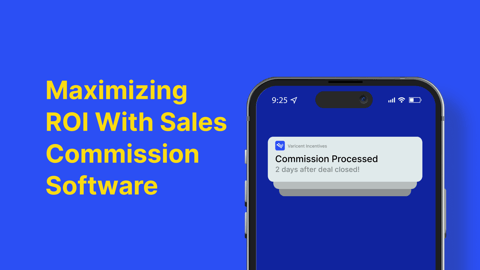Fair and attractive sales commission structures translate into motivated and engaged salespeople. There are a variety of sales commission structures to choose from, and each model offers something slightly different in terms of base salary, commission rate, and/or bonuses.
Precise and robust sales commission structures help salespeople understand how their performance is rewarded. What’s more, sales commission structures ensure salespeople are paid accurately and on time and streamline the process of planning, implementing, and managing sales incentives.
Designing a sales commission structure that suits your business demands careful thought. Remember, it will shape your people’s behavior and determine your costs. And, once you’ve committed to a structure, it’s difficult to rectify any mistakes retrospectively, so it’s a good idea to invest time and effort upfront in planning your approach.
So, what options for different sales commission structures are available?
Let's start with the basics.
What is Sales Commission?
Sales commission is the variable part of a compensation package tied to the value of customer transactions. The commission value should be predictable before a transaction closes to help keep the salesperson focused on closing the business. Sales commission structures help to ensure this.
Commission differs from a bonus, as bonuses are incentives, likely tied into a team or company performance measure that an individual has little direct influence over. Non-financial rewards, such as gym membership, earning store vouchers, or other special sales trip incentives might form part of the broader issue of Incentive Compensation Management (ICM). Managers should approach these incentives with the same care as designing their sales commission structures.
What is a Sales Commission Structure?
Sales commission structures focus on the design of commission models that shape the behavior of the sales team. A typical sales commission structure may feature a base salary component, a variable commission component, and other incentives. Some sales commission structures are simple; others are more complex, reflecting differing complexities of sales processes.
However complex sales commission structures may be, they must be easy to understand. A salesperson needs to see how performance shapes their pay. Sales commission structures also make it easy for a company to manage and administer incentives, with minimum commission clawbacks necessary.
The Importance of the Sales Commission Structure
Sales commission structures define the behavior that a company values most. It isn't easy to overstate their significance. Get them right, and they work for everyone. However, should you miss the mark, the company might end up paying out too much commission, and its profitability will take a hit. Pay too little, and salespeople will quickly move on.
A typical sales commission structure is in place for a year, so making changes to sales commission structures to fix problems mid-flight is fraught with difficulty. Issues need to be prevented from getting into the final model in the first place. That said, an innovative sales commission structure should be flexible enough to enable the use of additional month-end, quarter-end, and year-end incentives if needed.
Types of Sales Commission Structures
Clearly, sales commission structures matter. What options do you have to help you create the ideal one for your business?
Straight Commission
The straight commission model is a sales commission structure where an individual is paid commission exclusively. There’s no base salary. This sales commission structure will drive behavior focused on closing business but at the risk of closing business that might not be right for the customer or your company. In principle, this sales commission structure is easy to design and manage, and sales staff should know their likely commission from a deal before they close it.
Base Salary + Commission
Base salary + commission models are the typical sales commission structures most used by companies. A salesperson receives a base salary with a variable component that takes them to an on-target earnings (OTE) income.
This sales commission structure balances risk for everyone, as salespeople can afford to be more selective about the business they take on, so relationships need not suffer. Again, a salesperson should know their commission expectations before closing a deal, with minimal management overhead for the business.
Base Rate Commission
This sales commission structure involves no commission at all. Salespeople receive a base salary, regardless of performance. This structure might feature in a highly regulated environment, such as pharmaceuticals, where ethical considerations about commissions might be an issue.
That doesn’t mean ICM doesn’t matter. There may also be a company bonus plan or non-financial rewards. These still need to be planned and managed.
Revenue Commission
Revenue commission models are sales commission structures often used with commission-only models or base salary + commission models. With this approach, a person earns a defined commission on the revenue they generate. This model is simple to understand and manage.
Companies typically use this sales commission structure when selling clearly defined products that require no services to use them.
Tiered Commission
The tiered commission model brings more sophistication to incentive schemes. Companies will use a tiered sales commission structure model in commission-only and base salary + commission models. Accelerator incentives increase commission rates as quota achievement rises. The aim is to ensure that “success breeds success” and keep all staff highly motivated until year-end. This sales commission structure also allows management to fine-tune the sales effort mid-year by modifying the accelerators if they need to.
A tiered sales commission structure maintains focus on sales but needs to be well managed to avoid disappointment and frustration. The quota levels at which accelerators kick in need to be clearly defined, and year-to-date quota achievement metrics updated regularly.
Gross Margin Commission
Gross margin commission is another sophisticated sales commission structure. It measures the profitability of a transaction rather than just the plain revenue. This is often an issue where implementation services are needed to use a product or where there’s been a costly sales effort required to close a deal.
The challenge here is to bring clarity and accuracy to these cost elements. Not all transactions will be the same, and some will involve more services and costs than others. This all needs to be captured and reported on accurately to avoid misunderstandings.
Draw Against Commission
The commission draw model is a common sales commission structure for new starters and business teams. Commission is paid upfront, ahead of business being closed, to maintain focus and motivation. The commission paid upfront is later clawed back as business is closed.
The challenge here is ensuring that sales teams and management understand what commission has been paid, what revenue has been generated, and how clawbacks will be implemented. Clarity, accuracy, and transparency are essential to maintain sales teams’ focus and motivation.
Residual Commission
The residual commission model is a sales commission structure where a salesperson is paid over time, likely reflecting the long-term nature of a contract. It benefits the company as commission is paid as revenues come in, and it’s a predictable income stream for account managers.
This model relies on accurate information about the contract length, any terms and conditions, and the relevant commission rates to make it work effectively.
Territory Volume Commission
The territory volume commission model is typically designed for teams rather than individuals. It’s ideal for teams managing large accounts, where several people are involved in maintaining the relationship and closing transactions. Here a group of salespeople is paid on the total territory volume, regardless of who closed the business. This may well be used where third-party distributors are the main route to market.
Again, the challenge here is to ensure that salespeople are paid for the right accounts and revenue targets, especially where an extended sales team manages a large volume of accounts.
Multiplier Commission
Multiplier commission models are the most sophisticated sales commission structures, and which – with the right ICM tools – can most effectively motivate salespeople to meet the needs of the business.
Here a base commission rate is paid, but the exact rate depends on variable multipliers applied to calculate the ultimate commission rate on a transaction. Variables like quota achievement to date, whether a deal involves new or existing products, or an existing or new relationship might be applied depending on the behavior the business is encouraging.
While these sales commission structures can be very sophisticated, care needs to be applied to ensure the basic sales information is correct. The data capturing all the relevant variables needs to be current, accurate, and transparent. The alternative risks frustrated and confused sales teams.
How to Choose the Best Sales Commission Structure for Your Business
Choosing the best sales commission structure for the business will depend on factors such as the company's growth stage, the type of product on sale, the complexity of the sales cycle, and the channel to market.
As a rule of thumb, smaller businesses that address simple customer needs and have a tightly knit sales team can support more straightforward sales commission structures. Larger, more distributed companies addressing more complex customer needs will likely need more complex sales commission structures.
Closing Thoughts
Sales commission structures are most effective when they’re thoughtfully selected and well designed and managed. It shouldn’t just be a question of “what commission rate should we pay?”
We trust that this overview will put you on the path to selecting the best sales commission structure for your business.
If you feel you could benefit from additional guidance and support, Varicent stands ready to help. Our powerful ICM solution helps you choose from the different sales commission structures open to you. And sophisticated “what-if” planning capabilities allow your managers to understand which structures will work best for them.
Learn more on how you can leverage incentive compensation management to build the best sales commission structure for your organization, or alternatively, jump straight to a demo.




